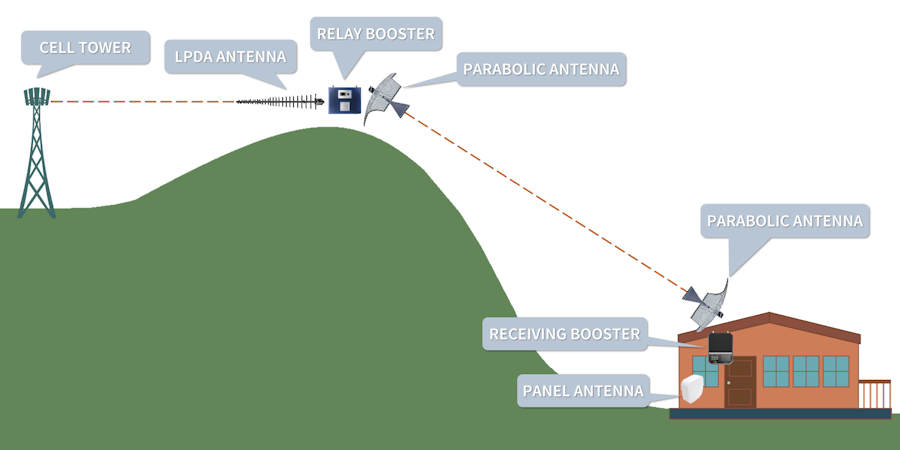Knowledge Base
Can I use a cellular booster in an area with strong signal as a relay to a booster that has no signal?
This is a frequent question we get at Powerful Signal. The situation is often something like this:
- The owner’s home is in a valley or other sheltered place where there is no cell signal available that can be amplified.
- The homeowner has a spot of land some distance away (and usually at a higher elevation) where there there is excellent or good cellular signal available.
- The homeowner wants to put a cell signal booster at the site where there is good signal (the relay booster) and have it send its amplified signal to another booster at their home (the receiving booster) that will rebroadcast it.
It may be possible to relay signal from one booster to another. This type of solution might work if you meet all of the following conditions:
- The home with the receiving booster is in an area with no ambient cell signal, including at 30 to 50 feet above ground level. (If you have signal at elevation, it’s better to place an antenna on a tower or pole and connect it to a booster inside the home via a low-loss coax cable.)
- The relay booster is placed in a location that has strong ambient cell signal, preferably −90 dBm RSRP or greater. (Learn more about cell signal strength and how to measure it.)
- The relay booster has access to 120V AC or 12V DC electrical power. (A solar array is an acceptable power source.)
- The relay booster uses a high-gain directional antenna (LPDA or parabolic) as the donor antenna pointed at the cell tower and another high-gain directional antenna as the broadcast antenna pointed at the receiving booster.
- The two antennas at the relay booster are pointed away from each other. (They may also need some physical separation.)
- The receiving booster uses a high-gain directional antenna (LPDA or parabolic) as the donor antenna pointed at the relay booster.
- There is a direct line of sight between the relay booster’s broadcast antenna and the receiving booster’s donor antenna. (No trees, hills, or other impediments between the two antennas.)
- The relay booster and the receiving booster are both sufficiently powerful to transmit signal between one another. (Contact Powerful Signal for recommendations on booster models that may work in your situation.)
Even having met all those conditions, Powerful Signal can’t guarantee that a relay setup will work for everyone. We’ve experienced success in several locations with this type of solution, but your specific circumstances may prevent it from working for you.
Even solutions that do work typically have some limitations, including:
- The distance is limited between the relay booster and the receiving booster. Under most conditions, you should expect a maximum feasible distance of 1,000 to 2,000 feet between the two boosters. (We have seen working examples of up a mile of separation, but these are exceptional.)
- Using a relay booster introduces noise into the cellular signal. This usually doesn’t create a problem for phone calls, but lower-quality signal often results in slower cellular data speeds. (Learn more about cell signal quality and how to measure it.)
- You’re unlikely to receive higher-frequency cellular bands, like AWS and PCS, that offer faster cellular data rates. You’re more likely to receive only lower-frequency bands, like CLR and SMH, that have slower data rates.
If you’re interested in pursuing this type of solution on your property, please give us a call at 435-634-6800 and ask to speak with one of our technical support representatives. Powerful Signal has a great deal of experience with these types of setups, and we’d be happy to advise you on your specific situation.


